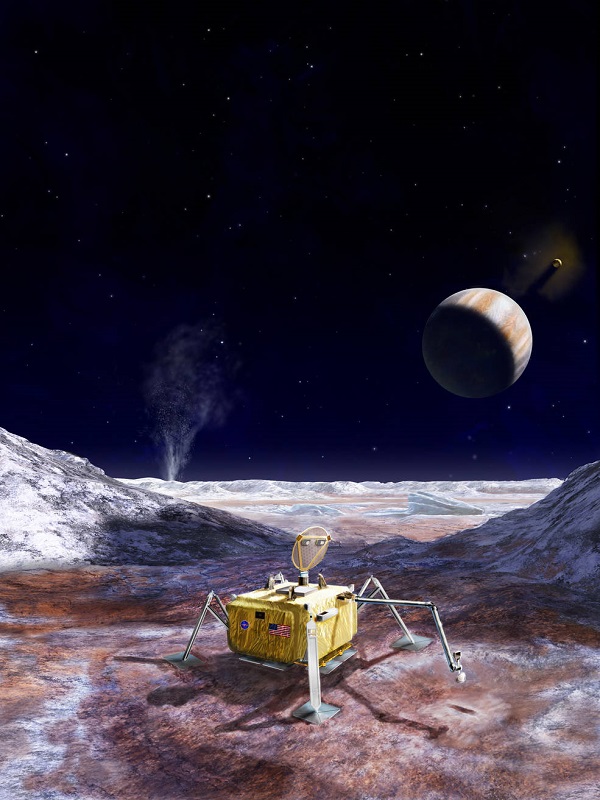By Ana Verayo, | February 12, 2017

This artist's rendering illustrates a conceptual design for a potential future mission to land a robotic probe on the surface of Jupiter's moon Europa.
Apart from Mars, NASA is planning to explore the rest of the solar system to search for life and now, mission scientists are targeting Jupiter's moon Europa. Now, NASA's Planetary Science Division is examining the possibility of placing a robotic lander on Europa.
NASA scientists released a new report that details this Europa landing mission, revealing how to search for signs of life on the moon. This mission is also slated for 2024 where there would also be an accompanying Europa flyby mission to collect data and other crucial information about surface conditions on this alien world.
Like Us on Facebook
In one of the most ambitious landings ever, scientists will attempt to land on this highly radioactive environment that can destroy equipment and electronics. A radio signal from Europa can take 42 minutes to travel and Europa's moon also do not possess any atmosphere, making surface conditions extremely harsh.
NASA scientists also say that this mission will last from 20 to 40 days depending on the lander's battery performance. The lander's primary goal is to obtain imagery from the surface of Europa and collect organic samples. These samples will be analyzed on site with the lander's onboard suite of scientific instruments such as spectrometers and a microscope to identify organic cells.
Another goal of this Europa mission is to analyze this material taken from the surface of Europa and determine the habitability of the moon. More specifically, apart from sampling ice materials, the lander will also evaluate the distance of the landing site from the water plumes, hidden pools and underground lakes.
Scientists also suggest that a subsurface global ocean exists within the interior of Europa and this mission will confirm if this massive body of water exists. To date, Europa is only one of two moons in the solar system to possess an ocean. The presence of flowing or liquid water on a planet or moon can indicate signs of life, especially microbial life.
Despite Europa being devoid of an atmosphere, with virtually no oxygen and hydrogen, which are the building blocks of life, scientists believe that life lurks within the moon's mysterious subsurface ocean. When this mission successfully detects this global subsurface ocean, scientists can now evaluate Europa's surface and subsurface for future landing missions.
When a larger spacecraft arrives, its goal is to find a way to gain access into this hidden ocean underneath the moon. This NASA report will be discussed during the Lunar and Planetary Science Conference 2017 in Texas this March and during the Astrobiology Science Conference 2017 in Arizona this April.
-
Use of Coronavirus Pandemic Drones Raises Privacy Concerns: Drones Spread Fear, Local Officials Say

-
Coronavirus Hampers The Delivery Of Lockheed Martin F-35 Stealth Fighters For 2020

-
Instagram Speeds Up Plans to Add Account Memorialization Feature Due to COVID-19 Deaths

-
NASA: Perseverance Plans to Bring 'Mars Rock' to Earth in 2031

-
600 Dead And 3,000 In The Hospital as Iranians Believed Drinking High-Concentrations of Alcohol Can Cure The Coronavirus

-
600 Dead And 3,000 In The Hospital as Iranians Believed Drinking High-Concentrations of Alcohol Can Cure The Coronavirus

-
COVID-19: Doctors, Nurses Use Virtual Reality to Learn New Skills in Treating Coronavirus Patients







